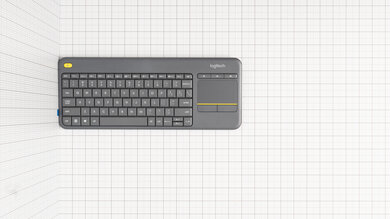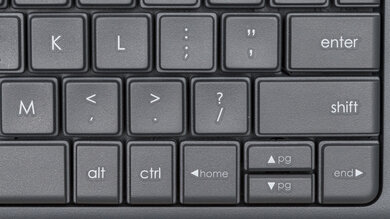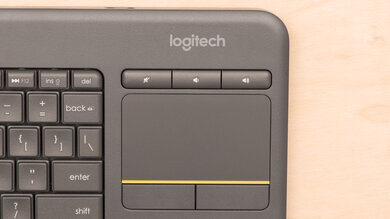The Logitech K400 Plus is a mediocre wireless keyboard with an integrated trackpad designed for using with a smart TV or HTPC. The all-plastic board shows quite a lot of flex and torsion, and its ABS keycaps feel slippery, but it feels light to type on. It isn't a good choice for programmers or gamers due to the lack of programmable keys and backlighting, but it's decent for office use as its typing noise is very quiet. Also, it has dedicated volume control keys and a built-in trackpad, which is helpful for use with a TV or HTPC.
Our Verdict
The Logitech K400 Plus isn't designed for gaming. Although it has a low pre-travel distance and it doesn't require much force to actuate each key, it has no macro-programmable keys or backlighting, and its latency is fairly high.
-
Decent ergonomics.
-
No macro-programmable keys.
-
No backlighting.
The Logitech K400 Plus doesn't support Bluetooth, so it isn't suitable for mobile devices.
-
No Bluetooth support.
The Logitech K400 Plus is a decent keyboard for the office. Its low profile design shouldn't cause much fatigue, but the small spacing between keys may cause a lot of typos. On the plus side, it's very quiet and shouldn't annoy those around you.
-
Decent ergonomics.
-
Quiet typing noise.
-
Decent OS compatibility.
-
Compact and tight key layout.
-
No multi-device pairing.
-
Poor software support.
The Logitech K400 Plus is inadequate for programming. Although it has decent ergonomics, it lacks backlighting and you can't program macros to any of the keys. On the upside, it's compatible with macOS and Linux, although only partially.
-
Decent ergonomics.
-
No macro-programmable keys.
-
No backlighting.
The Logitech K400 Plus scores low for home theatre PC setups since it doesn't have Bluetooth or backlighting. However, if you don't care about those features, the Logitech K400 Plus has a built-in trackpad to easily navigate your PC without a mouse. Also, it has volume control buttons and media hotkeys. There's a left mouse click button on the top left of the keyboard, so you can navigate the trackpad with your right thumb and click with your left.
-
Built-in trackpad.
-
Volume and media keys.
-
No backlighting.
-
Doesn't support a Bluetooth connection.
-
No multi-device pairing.
-
Poor software support.
- 6.0 Gaming
- 3.4 Mobile/Tablet
- 7.1 Office
- 6.0 Programming
- 3.4 Entertainment / HTPC
Changelog
- Updated Feb 27, 2024: We've added a link to the newly-reviewed HHKB Studio in the Extra Features section of this review.
- Updated Jun 21, 2023: We've converted this review to Test Bench 1.2. This update introduces new Backlight Features and Backlight Clarity test boxes. We've also added a new Switches test box, added additional test comparisons to our Hardware Customizability test box that we introduced with our last Test Bench. For an in-depth look at our changes, you can see our full changelog here.
- Updated May 26, 2023: We've converted this review to Test Bench 1.1. This update adds several new tests addressing Hardware Customization, Macro Keys And Programming, and Wireless Mobile Compatibility. We've also added new objective evaluations to the Typing Noise test, and we've simplified several tests and removed several others that were no longer relevant. For an in-depth look at all our changes, you can see our full changelog here.
- Updated Oct 29, 2021: Downgraded the build quality score.
- Updated Jul 09, 2021: Updated our verdict for the Entertainment / HTPC usage.
Check Price
Differences Between Sizes And Variants
The Logitech K400 Plus keyboard is available in both black and white, but the white model seems to only be available in some regions. Although we tested the black variant, we expect the white one to perform the same. You can see our unit's label here.
Compared To Other Keyboards
The Logitech K400 Plus serves its purpose as a wireless media keyboard with a trackpad, and it's designed to use on the couch while connected to a smart TV. It's very similar to the AmazonBasics K4R and the Corsair K83 Wireless, but it might provide better value for some users. For other options, see our recommendations for the best keyboards, the best wireless keyboards, and the best keyboards for writers.
The Logitech K380 is a better keyboard than the Logitech K400 Plus. The K380's compact size is easier to travel with, and it can connect to any mobile device with Bluetooth support, unlike the K400 Plus. However, the K400 Plus does have a trackpad which makes it more ideal for a smart TV set up.
The AmazonBasics K4R and the Logitech K400 Plus both have a built-in trackpad in place of a Numpad. They're very similar keyboards, but the Logitech requires less force to actuate a key, and it has a second left-click button on the top left of the keyboard. Also, unlike the AmazonBasics, the Logitech has a companion software that allows you to make some customizations to the keyboard.
The iClever Tri-Folding Keyboard BK08 is better than the Logitech K400 Plus for mobile devices, thanks to its Bluetooth support and better portability. The Logitech isn't designed for mobile devices, but it has better ergonomics due to its slight incline and it has a companion software that allows you to make some customizations to the keyboard.
The Logitech K480 is better than the Logitech K400 Plus for mobile devices thanks to its Bluetooth support and its cradle for phones and tablets. However, the K400 Plus is better for office uses due to its better ergonomics and typing quality, and its better suited for home theater setups thanks to its built-in trackpad.
The Lenovo ThinkPad TrackPoint Keyboard II and the Logitech K400 Plus are compact boards with integrated mouse controls. While the Logitech uses a trackpad to move the cursor, the Lenovo uses a rubber pointing stick above the B key like Lenovo laptops tend to have. The Lenovo is better for use with mobile devices and tablets thanks to its Bluetooth support, but unfortunately, it can only pair to one device via Bluetooth and one via USB receiver, which may not be enough for some people. Neither board has backlighting, which isn't ideal if you need to use it in the dark.
The Corsair K83 Wireless is a better multimedia keyboard than the Logitech K400 Plus. The Corsair looks and feels better built, and, unlike the Logitech, it has backlighting and Bluetooth support. However, the Logitech might provide better value for some users since it's more budget-friendly.
The Logitech K780 is overall a better keyboard than the Logitech K400 Plus. Unlike the K400, the K780 can pair with up to three devices at once via Bluetooth. The K780 also features a built-in stand for phones or tablets, making it the better choice for typing on a mobile device. On the other hand, the K400 Plus is better for a home theater setup thanks to its integrated trackpad and is designed to be used on your lap.
The Logitech MX Keys is a better keyboard than the Logitech K400 Plus. The MX Keys has a rechargeable battery and can pair with up to three devices at once via Bluetooth, unlike the K400 Plus that uses AA batteries and doesn't support Bluetooth. The MX Keys also has a built-in brightness sensor that will turn on backlighting to help you type even in darker rooms. However, the MX Keys has a Numpad instead of a trackpad, so you would need to have an accompanying mouse if you wanted to use it with a home theater setup.
Test Results
This keyboard is similar in size to most TKL keyboards, but it includes a built-in trackpad like other entertainment keyboards. It's fairly light and is small enough to use on your lap when connected to a smart TV.
Update 10/29/2021: We downgraded the build quality score from 7 to 6 because its build feels more like the AmazonBasics K4R, and it feels cheap.
The build quality is mediocre. Its plastic frame gives a lot of flex and torsion, which isn't great, but it doesn't feel as though it's going to snap in half. The keys aren't stable, the spacebar rattles, plus the left and right trackpad buttons feel loose.
Note: While there are many reports of people having issues with the trackpad not scrolling well and registering double clicks, we didn't experience any issues with the trackpad while testing the Logitech K400 Plus. If you own it and have experienced issues, let us know in the discussions.
The ergonomics are decent. Although there aren't any incline settings or an included wrist rest, its low-profile design shouldn't cause much fatigue. The keys are quite close to each other, but your hand should still feel comfortable and not too cramped.
This keyboard doesn't have any backlighting.
The Logitech Wireless Touch Keyboard K400 Plus keyboard is wireless-only, and since it uses disposable batteries, no charging cable is included.
This keyboard only works with its proprietary receiver.
The Logitech K400 Plus has dedicated volume control keys and uses hotkeys for media control. There's also a left-click button on the top left so you can navigate the trackpad with your right thumb and click with your left. Although there's no Windows Key lock button on the keyboard, you can disable it in the Logitech Options software. However, you need to open the software each time you want to toggle the lock on or off since you can't remap any of the hotkeys to do it. If you want a board with a TrackPoint instead of a trackpad, check out the Lenovo ThinkPad TrackPoint Keyboard II.
This keyboard also has an integrated trackpad. Some people have reported experiencing issues with it, but we didn't experience them during testing, though we don't test the trackpad as part of our test bench.
If you're interested in a wireless keyboard that has a pointing stick and mouse buttons instead of a trackpad but also incorporates programmable gesture pads and a much more premium-feeling build quality, see our review for the HHKB Studio.
The Logitech K400 Plus keyboard uses rubber dome switches that feel like scissor switches and require a bit of force to actuate, though the overall feeling remains light. Due to the membrane switches, pressing a key can feel a bit mushy.
The typing quality is okay. The ABS plastic keycaps feel slippery, and they also feel a bit mushy to type on due to the membrane switch. There isn't much space between each key, so the risk of typos is high since it might be hard to tell when your finger is in-between two keys. On the plus side, the keys feel pretty stable and the low profile design shouldn't cause much fatigue.
The Logitech K400 Plus' typing noise is very quiet, so it shouldn't be bothersome in a noise-sensitive environment.
The Logitech K400 Plus has fairly high latency. While it may not be suitable for gaming, it should be more than fine for browsing the web.
The Logitech K400 Plus has poor software support. The Logitech Options software allows you to remap some of the function keys, but you can only choose from a drop-down list of presets. You can disable the Window Key from the software, but you can only do it from within the software and you can't program any of the function keys to toggle the lock.
On Windows and Linux, all default key functions work. On macOS, the Insert key and the hotkeys for F1, F2, and F9 don't work.
Comments
Logitech K400 Plus: Main Discussion
Let us know why you want us to review the product here, or encourage others to vote for this product.
- 21010
Long time supporter and I sent a different email with similar concerns sent separately. This is a lot of effort and policy to make the website worse. Your actions would be intentionally making the website worse for the general public, expanding the plague of enshitification on the internet. That is in direct conflict with the purpose of this community that you have grown over the past many years. Ads are very tacky, mission compromising, distracting, and unhealthy for the youth and neurodivergent engineers. Are you sure you are not stretching your team too far or adding unnecessary content that is requiring this extra revenue? We don’t need greed destroying another useful tool and community. If this new content is valuable then you should add it and other benefits to entice a higher supporter contribution. Make this place more valuable before making it worse. You will lose revenue and respect if you put ads in your reviews.
Thank you for sharing your concerns. Your concerns are valid and resonate with overall sentiments of our community. As we have stated earlier, decision to introduce ads was not taken lightly. Its not about greed but its critical for our long-term sustainability and independence of our site. We will make sure that there is little impact on user experience. Our paid subscribers (Insiders) will not be shown any ads. To address your concern about stretching our teams too far, we will not compromise on quality of our testing and content in any which way. We’d also love your and others input as we roll this out to ensure we’re doing it right. Thanks
- 21010
Long time supporter and I sent a different email with similar concerns sent separately. This is a lot of effort and policy to make the website worse. Your actions would be intentionally making the website worse for the general public, expanding the plague of enshitification on the internet. That is in direct conflict with the purpose of this community that you have grown over the past many years. Ads are very tacky, mission compromising, distracting, and unhealthy for the youth and neurodivergent engineers. Are you sure you are not stretching your team too far or adding unnecessary content that is requiring this extra revenue? We don’t need greed destroying another useful tool and community. If this new content is valuable then you should add it and other benefits to entice a higher supporter contribution. Make this place more valuable before making it worse. You will lose revenue and respect if you put ads in your reviews.
- 21010
Hello Dylan and Rtings supporters. I wanted to post the email I sent to Rtings directly so that this may be addressed publicly. […] Dylan, I got a response back from the team, but I wanted to know if you had anything to add publicly. I think this would something that we would all appreciate.
Here was my email response in case others are interested to see:
Thanks for the feedback. We do care about privacy, which is why a few years ago we stopped using Google Analytics and switched to a privacy friendly alternative (plausible.io). For paid insiders, no new third-party code will be loaded client side since no ads will be displayed. For non-paid visitors, we will use a Consent Management Platform that is GDPR compliant. Basically, it will ask you if you want to accept third party cookies. Also, we won’t try to go around adblockers for those who have one installed. Hopefully that address your concerns. Thanks,
- 43230
Hello Dylan and Rtings supporters.
I wanted to post the email I sent to Rtings directly so that this may be addressed publicly.
“As a longtime supporter, channel subscriber, and Insider member, I’m writing regarding the recent announcement about showing ads to non-Insider users.
While reviewing both the "How We Make Money: While Staying Unbiased” and “You Might Start Seeing Ads on RTINGS.com” pages, I noticed a critical topic missing from the discussion: tracking and privacy.
In today’s digital landscape where data collection is pervasive, I’m concerned about how RTINGS will handle user privacy with these new advertisements:
What measures are being implemented to prevent invasive user tracking? Will these ads collect and share user data with third parties? Are there safeguards to ensure visitor browsing habits aren’t being monitored and sold?
This represents a significant consideration that deserves transparent communication, especially as data harvesting becomes increasingly aggressive across the web. As someone who values both RTINGS’ unbiased approach and my online privacy, I’d appreciate hearing how these concerns are being addressed.
Thank you"
Dylan, I got a response back from the team, but I wanted to know if you had anything to add publicly. I think this would something that we would all appreciate.
- 43230
Can we have strong guarantees that you will maintain your independence? Your reviews follow a strict and methodical process that treats all brands and products equally, but who is to say that 5/10 years from now you will not purposefully avoid testing a product because your biggest advertiser knows it’s crap but is profiting heavily from it? Or even more insidiously, what if your review processes slowly update and evolve to the whim of your top advertisers? Say, you update your headphone target curve to favor the sound of one brand that advertises here so it has a better score even though it is not the sound people will prefer. This would feel especially wrong for your paid subscribers (of which I am not one at the moment), as they would be paying for and endorsing biased reviews and methodologies.
For starters, I just want to say that I totally understand where you’re coming from. Your concerns are valid, and these are things we’ve considered and discussed to great lengths internally. Our goal was to roll this out, but in a way that still stays true to us, and most importantly allows us to maintain independence. We can say with confidence that we’re doing (and will continue to do) all that we can to ensure this does not change. And we won’t make changes that we feel aren’t in line with some of the values we’ve prioritized until this point.
This is also big reason we’ve made the decision to keep our editorial and monetization team separate. We want to reduce any risk of ads having an impact on the products we buy and test, and vice versa. As for your concerns about testing, I really want to stress that our methodology is heavily influenced by the feedback we get from users. That isn’t going to change. We’ve also limiting the ads we intend to allow, so we don’t expect there to be an overlap that causes any risk.
I’m curious though, is there anything more you think we can address in the article we linked to this post that could do a better job addressing your concerns and others users might have?
- 21010
Would it be a good suggestion to make Insider members ad- free ?
- 21010
Can we have strong guarantees that you will maintain your independence?
Your reviews follow a strict and methodical process that treats all brands and products equally, but who is to say that 5/10 years from now you will not purposefully avoid testing a product because your biggest advertiser knows it’s crap but is profiting heavily from it? Or even more insidiously, what if your review processes slowly update and evolve to the whim of your top advertisers? Say, you update your headphone target curve to favor the sound of one brand that advertises here so it has a better score even though it is not the sound people will prefer.
This would feel especially wrong for your paid subscribers (of which I am not one at the moment), as they would be paying for and endorsing biased reviews and methodologies.






























